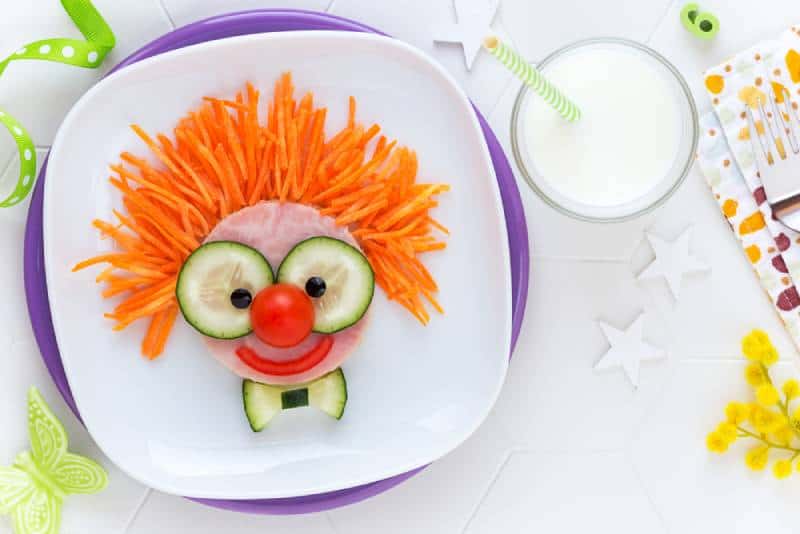There probably isn’t a parent out there who hasn’t racked their brains over trying to figure out how to get a child to eat when they refuse. Sadly, this is a stage almost all children go through.
I won’t lie to you: Having to deal with this issue is stressful, frustrating, and everything but easy. However, the good news is that this is resolvable and that you will get through this stage, one way or another.
After all, your child won’t refuse to eat forever. That said, there are certainly some things you have to do to prevent this from turning into a lifelong habit.
Here are professional yet simple tips on how to get a child to eat when they refuse and reasons why they might be refusing food.
How To Get A Child To Eat When They Refuse
1. Get rid of distractions

In today’s world, a kid watching TV, playing games, and using a phone or a tablet while eating is nothing unusual. Let’s face it. For many parents, it’s much easier to keep their kids calm with the help of these gadgets.
However, this method is everything but efficient. It might keep your kid quiet for a few moments, but in the long run, it can bring about numerous other eating problems.
One thing common for almost all children out there is their short attention span. Young children get easily distracted by everything going on around them and can’t keep focus on one thing only the way us adults can.
The same happens during mealtime. Sometimes, a child refuses to eat simply because he considers sitting down and putting food in his mouth incredibly boring. He’s much rather concentrate on the world around them.
On the other hand, if there isn’t anything else for them to focus on, he’ll go back to eating in no time.
This is exactly why it’s your duty to get rid of all possible distractions that can keep your child’s interest off food. Don’t allow him to do anything else besides eating.
However, don’t forget to apply the same rule on yourself as well. After all, you can’t scroll through your social media feed during mealtime and expect your child not to do the same.
2. Mealtime routine

Even though it appears that children hate rules, the truth is that a certain level of strictness is necessarily for them. Yes, this is the difficult part of parenthood, but whether you like it or not, sometimes you have to be the bad guy and set up some order.
Therefore, if you’re wondering how to get a child to eat when they refuse, the answer is to set up some kind of eating system. Develop a mealtime routine and make sure it’s consistent.
Mealtime is a process that doesn’t only include eating. Instead, it also consists of setting up the table, washing hands, sitting down to eat, clearing the table, and washing the dishes.
Let your child have his own place at the big table together with the rest of the family . Don’t allow him to eat on the couch or lie in bed, watching TV.
Also, do your best to set up a regular eating schedule. I know you live a busy life and therefore can’t plan every single day in detail.
But you can put an effort into establishing a timetable. Make sure your child gets used to having breakfast, lunch, and dinner time at the same hour and in the same setting every day.
This way, he will start seeing eating as something that has to be done, whether he likes it or not. It’s not a game he can choose to participate in or not – it’s a part of life and it will remain like that forever.
3. Make food fun

Despite eating being obligatory, you can also make it fun. In fact, it is what you should do if you want to inspire your child to eat more and healthier.
You’ve already seen the concept of “happy meals.” Well, the problem is that they are always full of unhealthy, junk food.
The problem is, your kid connects good taste with these meals. So, why not use this to your advantage and make “happy healthy family meals.”
After all, you want your little one to like the food he’s eating instead of making the entire process torture for the both of you.
Turning mealtime into an enjoyable experience for the entire family is not as hard as it sounds. For example, it’s enough for you to decorate the food or serve it in tiny dishes.
Make your child feel special by letting him eat from dishes reserved for him only. You can buy plates and bowls with his most loved cartoon characters on or cups in his favorite color.
When you’re decorating food, pay attention to shapes. One good idea is to make muffin-tin meals. Basically, you put the food into a muffin tin instead of just serving it on a plate. This has proven to be especially effective when it comes to some new stuff your kid refuses to try out.
Another great thing you can do is use food colors. Instead of making your child eat plain yogurt, add some colorful fruit inside or swirl some funky-colored food coloring in it.
Serve it in a fun-shaped cup and add a few straws. Now, you’re giving them a smoothie or a cocktail that no kid will ever refuse.
Your kid refuses to eat bread? No problemo! Get yourself shaped cookie cutter shapes. Take a slice of bread and cut out the center.
Put whatever you want (e.g. eggs and meat) in the center and bake it all together. Serve the cut-out shape on the side.
Voila! You just made a fun breakfast in a blink of an eye.
There are numerous similar toddler food examples. For example, when you’re giving your child his vegetables, introduce him to veggie faces.
Use cucumber slices for eyes, julienne carrots for hair, a slice of tomato for the mouth, and a grape for the nose.
You can do the same with water. Instead of constantly giving your kid sugary juices, put some fruit such as orange or cucumber on the rim (or color the water by mixing in fruit pieces).
Unleash your creative side and I assure you it will pay off!
4. Include them in the food-making process

I know that you’re tired and probably not the happiest for the fact that you have to cook every day. However, make sure your child doesn’t see that meal preparation is a burden to you unless you want him to observe eating that way as well.
Instead, show him that you enjoy cooking. Not only that, include your kid into the food-making process and give him chores related to it.
For starters, give him some kind of autonomy. Offer him the opportunity to choose what he’ll eat.
Of course, this doesn’t mean that your child will be in the position to pick between chicken nuggets and cauliflower.
You determine the choices given. For instance, when making pizza, you can let him pick his toppings from a selection of tomato, pickles, peppers, spinach, cauliflower, and zucchini.
Then let his imagination run wild by encouraging him to decorate his own funky-looking pizza.
Trust me, he’ll be so thrilled for the fact that he’s got pizza for lunch that he’ll likely eat the veggies without batting an eye.
When you include your kid in cooking, it’s natural to not let him use a knife or other sharp objects. But there are things he can certainly give you a hand with.
Get him his own personalized apron and make him feel like a real chef. Depending on your child’s age, give him a few easy tasks to help him feel useful and grown-up.
Trust me, kids are quick learners. They need to be monitored at all times but will enjoy taking part in this adult activity. What’s even more important is that they’ll be more than happy to eat what they made with their own two hands.
5. Understand their appetite

Before anything else, you have to be completely familiar with your child’s appetite. Yes, there exist some ground rules regarding the amount of food every kid in a certain age should eat during the day. After all, a newborn eats way less than a toddler.
However, don’t you ever forget that your child is an individual. Therefore, you have to carefully listen to their needs. Don’t push them too hard but don’t allow them to stay hungry for too long either.
Another thing you have to consider is your child’s eating style. For example, someone’s body asks for a larger number of smaller portions while someone else feels better when they eat bigger portions fewer times a day.
It’s your job to figure out what suits your kid the best and to harmonize the rules and their own inner schedule.
6. No more grazing

The number one enemy of regular meals and a healthy diet is, without doubt, grazing. It is a practice of continuously eating small portions of food throughout the day.
Sadly, many kids find this normal and completely acceptable. Well, it’s not.
Whenever your child starts to feel hungry, he’ll grab the first food that he can get, and more often than not, it ends up being an unhealthy snack or junk food.
What happens is, instead of sitting down at the table and eating a proper meal, he’ll simply take a few bites of his favorite cookie. This way, his stomach is fooled into not sending signs of hunger anymore.
However, since he’s only eaten a small portion of food, soon enough, he’s hungry again. And so the vicious grazing cycle continues.
So, when it’s time to have the next meal, naturally, your kid isn’t hungry. In fact, he is stuffed and consequently refuses to eat. He ends up spending the entire day without actually having one decent meal.
Sadly, more and more parents let their children graze in between designated meals. They use food as a tool to calm their distressed kids, as a distraction, as a reward, or as a bribe.
I’m here to beg you not to do this, especially if you’re not giving them healthy snacks. You’re instilling in them bad habits that you’ll have a hard time correcting.
Hea me out: I’m not advising you to let your child go hungry in between meals. By all means, if this is the case, include a sit-down snacking time in your daily schedule.
This way, you’ll control what and how much your little one is eating. Also, this snacking time will become a part of a routine and grazing won’t be necessary anymore.
7. Keep offering new healthy food

Actually, the problem isn’t usually that a child refuses to eat anything whatsoever. Instead, most times it’s that kids draw up their noses and don’t want to eat a certain variety of foods. This generally starts to happen in the BLW stage.
To make the situation even worse, the food kids don’t want to eat is usually the healthiest option – that which they simply have to regularly consume for the sake of their growth and development.
Despite knowing this, many moms simply don’t have the strength for this power struggle. I’m sure you’ve already found yourself in a situation where you have two options: you either get temper tantrums and stand-offs or you give up the healthy food and let your young one eat his favorite food.
Often, it’s just easier to choose the latter when you’re on the verge of a breakdown and your child is consistent in flat-out refusing the food put in front of him. At least he’s eating something, right?
After a couple of days or weeks of this food war, you give in completely. You stop offering him new food and he ends up getting his way.
Well, I know that this is the easiest thing to do. However, this practice has to come to an end.
No matter what happens, always offer food that is balanced and healthy to your child. Be persistent and arm yourself with loads of patience.
Keep in mind that not all kids react the same to novelties. It’s nothing strange that your child has to be offered the same food multiple times before he grows to like it and starts eating it regularly.
The most important thing is to introduce one type of new food at a time. This will give your kid a chance to get used to the flavor and texture, and give you a clearer picture of your child’s allergies, intolerance to certain foods, and reactions to certain nutrition.
Wait around 3 to 5 days before offering something new.
Whenever you give your young one new food, make sure he sees you eating it as well. Set a good example and show him how tasty this healthy nutrition is.
When you present a certain food for the first time, start with small portions and then slowly introduce bigger helpings. Always tell your child what they’re eating and don’t forget to explain why this particular type of food is crucial.
One of the best ways to incorporate this new food is to serve it with already familiar meals. It will make your child feel like he has more than one option and may be more eager to try something unknown.
8. Feeding therapy

Finally, if you have tried all of the above yet still see no progress, seek help. Asking for a helping hand is not a sign of defeat and it certainly doesn’t mean that you failed as a parent.
Actually, it is proof that you’re mature enough and able to admit that some aspects of raising your little pumpkin are out of your reach. Moreover, it’s a sign that you want what’s best for your kid, at all costs.
Don’t go asking for advice from other parents, especially if you’re a new mom. Every child is different and other people’s experiences can only confuse you even further.
The best route to take is look for an expert’s opinion. Talk to your pediatrician, nutritionist, or therapist. Also, investigate the best food therapy options near you to evaluate which will be most appropriate for you and your child.
When you engage in food therapy, you’re actually receiving counseling from a therapist. This dietitian helps your child create healthy eating habits.
They know exactly what to do and how to push your child toward a better food intake – healthier and more often. They will tell you how to behave in mealtime situations and how to avoid mistakes throughout the process.
4 Reasons Children Refuse To Eat
If you’re a new parent, you probably don’t realize that not all feeding problems happen for the same reason. When figuring out how to get a child to eat when they refuse, most parents assume that their kid is just throwing tantrums and initiating a power struggle.
Even though it’s true that many children are simply picky eaters, their problem with food can also be due to some medical condition. Therefore, before you start pressuring your child to eat, you have to be clear about why your child refuses to eat in the first place.
1. Oral sensory problems

The difference between picky eating and oral sensory problems is huge, even though some might see it as the same thing. Namely, picky eaters simply don’t like a certain type of food – or to be exact, they don’t like most of what you’re offering on their plate.
On the other hand, if your child is experiencing an oral sensory problem, he experiences a sensory overload every time he tries to eat a certain food group (food of a certain texture, smell, or taste).
If this is the issue with your child, you’ll simply have to adapt to his senses, if you want to make him start eating. This is where feeding therapy would come in handy.
Some of the symptoms of oral sensory problems are gagging, vomiting, crying during eating time, chewing their tongue, and food falling out of the mouth.
For example, if your child tolerates only soft food, he’ll have the urge to vomit every time you make him eat solid food, so you have to use a blender for almost every meal.
Worry not, this is resolvable. Besides, these oral sensory problems don’t last forever.
2. Oral motor skills problems

If your kid is dealing with problems relating to oral motor skills, he essentially has trouble swallowing, sucking, licking, and/or chewing. These are some of the basic food-related tasks, so consequently, he’ll have trouble with food intake.
In this case, there may be an issue with the muscles in his jaw, mouth, or tongue. Your child might have a problem with controlling his muscles, coordination, or strength.
Therefore, eating can be quite difficult and almost impossible. The symptoms also include gagging, coughing, mashing the food with tongue, and choking.
Even though this is a quite rare condition, if you suspect it’s something your kid struggles with, you should definitely see a pediatrician.
They will show you some exercises to help your child develop these oral motor skills, for instance, licking a lollipop outside his mouth, singing, and touching his teeth with his tongue.
3. Eating disorders

Eating disorders are often thought of as an adult or teen issue. However, the truth is that even children under 12 years old can develop them.
Sadly, even young children can have anorexia nervosa or bulimia. Despite their young age, these children are very well aware of their body.
Not only that, they have a distorted body image. This can happen due to many reasons, be it peer pressure, anxiety, or depression.
Those who suffer from anorexia refuse to eat enough calories. Simply, they have this irrational fear that they will gain a lot of weight and become obese.
On the other hand, bulimia is when a person engages in binge eating. They intake too much food and later purge the food out of their body, also from fear of gaining weight.
This is a very serious issue you should deal with in a proper way. If you suspect that your child is struggling with any kind of an eating disorder, please seek professional help as soon as possible.
A mental health expert will firstly have to diagnose the disorder before acting on it. Early recognition and proper treatment are the key to successful healing.
4. Picky eater

Picky eating and food refusal is a problem many parents sadly have to deal with. It doesn’t appear with age – you can have a one year old fussy eater throwing tantrums simply because he doesn’t like the food put in front of him.
When food refusal happens, your child is actually testing your limits. He wants to see how far he can go and what he can get away with.
While this is not a health problem, it is a nightmare for all parents dealing with it. But don’t fret, almost all kids go through a phase of picky eating.
This is perfectly normal, especially for toddlers, since this is the age in which they develop their own food preferences.
If you’re a fan of democratic parenting style, you want to give your child his autonomy, but at the same time, you know that you have to get him to eat, one way or another.
What is important is to accept that your kids don’t have to have the same food tastes as you do. However, that doesn’t mean they’re allowed to skip healthy meals.
Be persistent and don’t give up. I promise you, this fussy eater stage will pass.
Conclusion
When you’re wondering how to get a child to eat when they refuse, remember that them getting all the necessary nutritious foods is your responsibility and a priority parenting goal. I know this isn’t easy, but it’s all a part of parenthood.
Arm yourself with patience and have faith that you can do it! Because you can!
Like this post? Please share or pin it for later. You can also stay in the loop and follow us on Facebook, Instagram or Pinterest.

This post contains affiliate links. Please see our full disclosure for more info.

